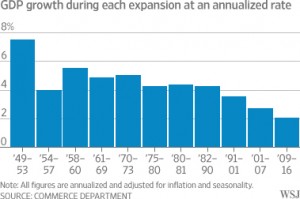U.S. GDP Grew a Disappointing 1.2% in Second Quarter
< < Go Back
Economic growth was well below expectations; cautious business investment offset robust consumer spending.
Declining business investment is hobbling an already sluggish U.S. expansion, raising concerns about the economy’s durability as the presidential campaign heads into its final stretch.
Gross domestic product, the broadest measure of goods and services produced across the U.S., grew at a seasonally and inflation adjusted annual rate of just 1.2% in the second quarter, the Commerce Department said Friday, well below the pace economists expected.
Economic growth is now tracking at a 1% rate in 2016—the weakest start to a year since 2011—when combined with a downwardly revised reading for the first quarter. That makes for an annual average rate of 2.1% growth since the end of the recession, the weakest pace of any expansion since at least 1949.
The output figures are in some ways discordant with other gauges of the economy. The unemployment rate stands at 4.9% after a streak of strong job gains, wages have begun to pick up, and home sales hit a post-recession high last month.
Consumer spending also remains strong. Personal consumption, which accounts for more than two-thirds of economic output, expanded at a 4.2% rate in the second quarter, the best gain since late 2014.
On the downside, the third straight quarter of reduced business investment, a large paring back of inventories and declining government spending cut into those gains.
“Consumer spending growth was the sole element of good news” in the latest GDP figures, said Gregory Daco, an economist at Oxford Economics. “Weakness in business investment is an important and lingering growth constraint.”
More From The Wall Street Journal (subscription required):




